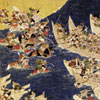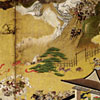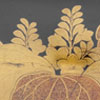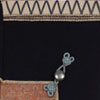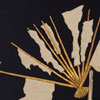Believed to be a divine descendant to the sun goddess, the emperor could not be deposed, but Yoritomo instituted a governmental system in which military lords ruled in the name of the emperor-a system that lasted nearly 800 years. The shogun and his court, comprising daimyo (feudal lords) and samurai (warriors), admired the social brilliance and artistic culture of the aristocracy and were eager to prove they were not unrefined ruffians. They generously patronized the arts, commissioning artists and craftspeople to create objects that suited their interests and tastes, and decorating their castles and mansions with painted folding screens and sliding doors, some depicting famous battles and military exploits.
Even in the relative peace of the Edo period (1615-1868), warriors were expected to be prepared for battle, and thus lavished extraordinary sums on military clothing and regalia. These garments often display artfully worked symbolic motifs that imply bravery and strength. Strict codes of dress that helped distinguish different classes-samurai, farmers, artisans, and merchants-began to dissolve by the mid-eighteenth century, and by the late nineteenth century it was possible for the rising middle class to purchase a higher social rank. The distinctive regalia of the samurai became increasingly ceremonial rather than functional. Relatively free to exercise personal choice for the first time, people of modest means incorporated patterns and family crests into the designs for their clothing, features formerly restricted to the military elite and aristocracy.



















